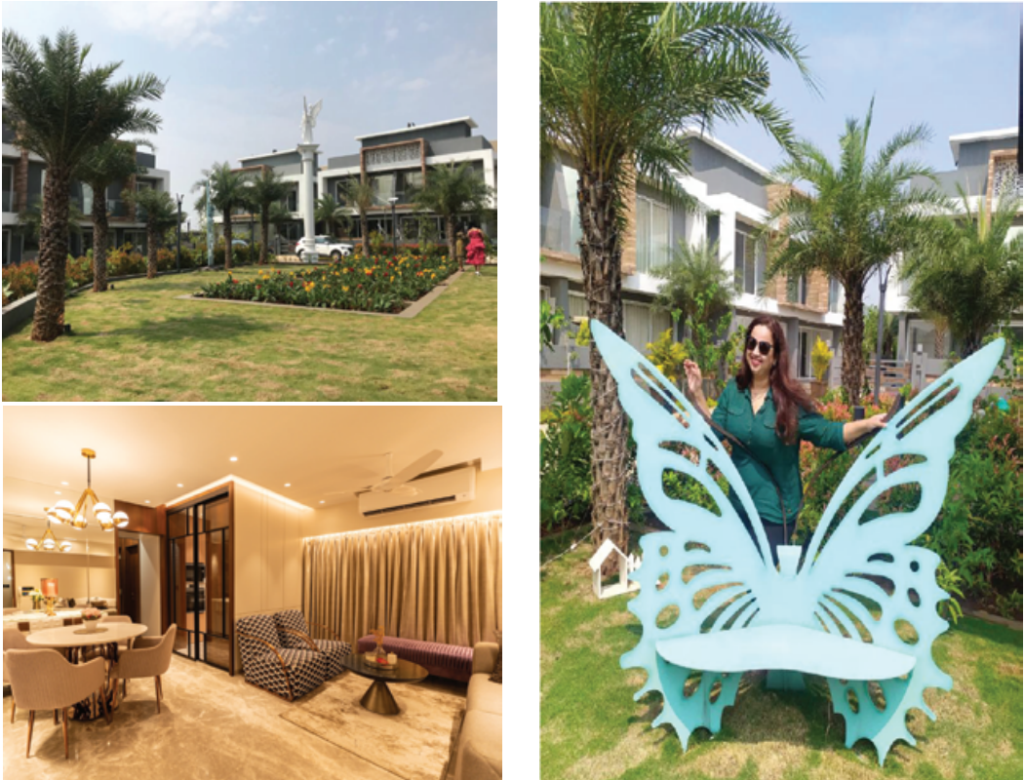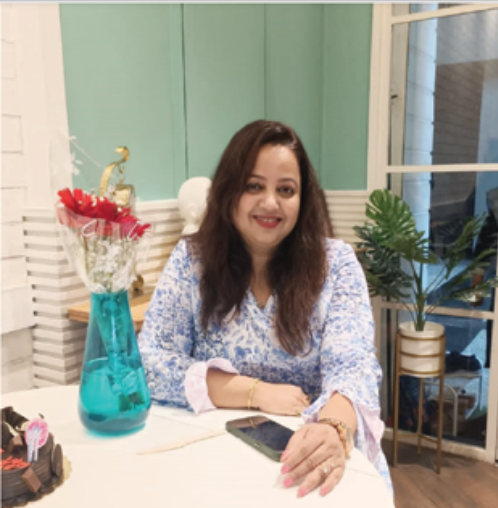“I take pride in translating complex ideas into visually compelling solutions and have a track record of delivering projects on time.”
Simple at heart, yet effervescent, Prajakta Karan Bharati (43) has sketching in her instincts and blood. An avid explorer of nature, her sketches are visual portraits of her artistic expression. Through her interior design company, Design Theory, she has been depicting her realms that have met wide acceptance.
In an informal chat with A. Radhakrishnan, she speaks at length on designs, their appeal, sustainability, what define ideal designs, and argues that one needs to constantly upgrade to keep pace with transformations that accrue in the industry.
Were you artistic as a child?
As a child I loved creating visual representations of scenes, objects, and people using various drawing techniques and mediums of expressive sketching. The pivotal moment was when I began teaching sketching to 40 students. It allowed me to exercise my creativity and led me to consider design as a career.
I did an interior design degree through SNDT Mumbai prior to graduating. My parents insisted that I complete my graduation because interior design was not yet a common profession. However, I had set my mind to carve a career in interior designing.
How did you enter this line?
My first project was creating a kitchen, and after that the impressed client requested that I also design her living room. My uncle then asked me to design a complete flat. In the process, I got a lot of clients who wanted to know if my projects were vastu compliant. Realising how important it was to my field, I also did a diploma in vastu.
I christened my business, Design Theory, as it summed up my experiences and passion for design in conjunction with the entire process theory. I take pride in translating complex ideas into visually compelling solutions and have a track record of delivering projects on time and collaborating effectively with diverse teams.
What is the difference between interior design and interior decoration?
Interior design involves a broader scope of work, including space planning, architectural considerations, and project management, while interior decoration is primarily focused on enhancing the visual aesthetics and style of a space through the selection and arrangement of decorative elements.
What is sustainable design?
Sustainable design, also known as green or eco-friendly design, focuses on creating interior spaces that minimise negative environmental impacts and promotes the well-being of occupants. It involves the conscious use of resources, materials, and technologies to reduce waste, conserve energy, and support ecological balance. The goal is to create spaces that are not only aesthetically pleasing, but also socially responsible and environmentally friendly.

Do you prefer functionality or appeal?
The preference between functionality and appeal in interior design depends on the specific context, purpose, and goals of the space. Both are essential aspects, and striking the right balance between the two is often the key to creating a well-designed space that meets the needs of its users.
To elaborate with an example, in a kitchen, functionality would involve designing an efficient layout that allows for easy movement and access to appliances, storage, and workspaces.
Appeal, on the other hand, refers to the aesthetics and visual attractiveness of the space. It involves the use of design elements, colours, textures, and furnishings that create a pleasing and inviting environment, and significantly impact the mood and emotional experience of the occupants, influencing their overall satisfaction with the space.
How do you understand your client’s requirements?
Asking the right questions to your clients is crucial to understanding their needs, preferences, and goals. Essential questions during the initial consultation include purpose and functionality, aesthetic preferences, budget and timeline, lifestyle and habits, spatial requirements, existing furniture and items, lighting and energy considerations, emotional response, accessibility and universal design, privacy and noise considerations.
Effective communication and active listening are vital. Encourage your clients to share as much information as possible, and use their answers to shape your design approach and create a space that aligns with their vision and requirements.
Who is the ideal home designer?
Designing a home requires careful consideration of various aspects to ensure that the space meets the needs and preferences of the occupants while creating a harmonious and functional environment.
An ideal home designer is not only skilled in design aesthetics but also possesses excellent problem-solving abilities and a deep understanding of how people interact with their living spaces.
What makes for an ideal kitchen design?
An ideal kitchen design is one that combines functionality, efficiency, aesthetics, and reflects the unique needs and preferences of the homeowners.
Ultimately, it is one that enhances their daily routines, and becomes the heart of their home where they can enjoy cooking and spending time with family and friends. Add personal touches and decor that reflect the homeowners’ tastes and lifestyle, making the kitchen a warm and inviting space.
What wood would you recommend for designing?
The choice of wood depends on the specific application, desired aesthetics, durability, the intended use, maintenance requirements, and budget constraints.
It should be ensured that the wood used is sustainably sourced and certified if environmental considerations are important to you. Commonly preferred wood types are oak, maple, cherry, walnut, mahogany, birch, ash, pine, teak and cedar.
What is a good way of using lights in your room?
Using lights effectively in a room can greatly impact its ambience, functionality, and overall aesthetics. Lighting can be Layered Lighting, combining different types of lighting to create depth and flexibility; Ambient Lighting is usually achieved through overhead fixtures like chandeliers, pendant lights, or recessed lighting; Task Lighting which focuses on specific areas for tasks such as reading, cooking, or working and includes desk lamps, under-cabinet lighting, and reading lights.
Accent Lighting which highlights architectural features, artwork, or decorative elements, using spotlights, wall sconces, or track lighting. Dimmers that allow you to adjust the light levels to suit different moods and activities, making the room more versatile. Natural Light by keeping windows unobstructed and using light-coloured window treatments which creates a pleasant and energising atmosphere.
Use of diffusers or frosted bulbs to soften the light and prevent harsh glares, especially in spaces where people spend extended periods, such as living rooms and bedrooms. Wall Washer fixtures distribute light evenly across walls, helping to make the room feel more spacious and balanced.
By carefully planning and integrating these lighting techniques, you can create a well-lit and inviting room that enhances the functionality and visual appeal of the space.
Which are the non-traditional areas where you can apply interior design and specialise yourself?
There are many non-traditional areas, allowing designers to specialise such as hospitality, healthcare, retail, exhibition and events, office, film industry, educational spaces, yacht and aircraft interiors, residential, public spaces, furniture design, wellness and spa.
These areas offer exciting opportunities for designers to expand their skills, explore their creativity.
What in your portfolio are you most proud of?
In 2016, we completed two office projects in the Congo Republic, and in 2017, a restaurant project in Cameroon, both in Africa. These were really challenging projects in designing and executing, but we delivered it successfully.
The 150 projects we have completed include many prestigious residential as well as commercial projects, among them, Mannat Villas, Tungarli, Lonavla, a 27 bungalow project which received the best project recognition from the Lonavla Municipal Corporation. I was also honoured with Best Interior Designer Award by BANM (Builders Association of Navi Mumbai) in 2010 in Stall Design category.
How do you keep up with industry changes?
It is essential for staying relevant, to keep informed, and competitive in the field. The interior design industry is constantly evolving, with new trends, technologies, and best practices. Some effective ways to stay updated are through continuous learning, industry publications, social media and design platforms, trade shows and events, professional associations, client feedback, networking, etc.
What advice would you like to give those who have chosen interior designing as their career?
Success in this field comes with perseverance, continuous learning, and a commitment to delivering exceptional designs that enhance people’s lives. Stay curious, keep exploring, and enjoy the journey. Formal degree or diploma in interior design builds a strong foundation and develop your skills further through workshops, online courses, and hands-on experience. A well-curated portfolio showcases your style, creativity, and versatility to potential clients and employers.


 A.Radhakrishnan is a Pune based freelance journalist, poet and short story writer.
A.Radhakrishnan is a Pune based freelance journalist, poet and short story writer.